Dec 06, 2025
Dec 06, 2025
History and interpretation of History define us in a big and deep way. A sense of who we are, what brought us here in the journey of civilization, and on what pillars do we stand - these factors are shaping elements of our collective mind. Therefore correct narration of history is vital. The presentation of history from all possible perspectives is a boon.
In case of Tribes of Bharat and their immense contribution to our freedom movement, their fearless spirit, and their seething anger against the atrocities of the colonial rule must be brought to the mainstream. In this series, we are listing our freedom fighters from the tribes of Bharat.
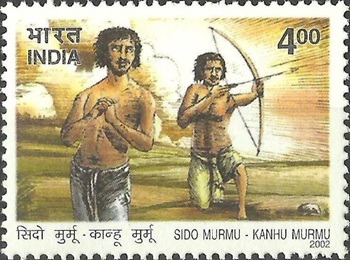 Sido Murmu and Kanhu Murmu were two brothers from the Santhal tribe Bhognadeeh, Sahabganj in Jharkhand. In fact, they were four brothers Sido, Kanhu, Chand and Bhairav. They were symbols of self-respect, and freedom in that area. Sido was born in 1815 and Kanho was born in 1820. They were fighters from Santhal Pargana area. They led a movement against the exploitation and repression of the British rule. They felt that they have been divinely ordained to establish a just and people friendly rule. They wanted the tribe to have a say in the management of official affairs. They had democratic aspirations. They desired to end the British rule.
Sido Murmu and Kanhu Murmu were two brothers from the Santhal tribe Bhognadeeh, Sahabganj in Jharkhand. In fact, they were four brothers Sido, Kanhu, Chand and Bhairav. They were symbols of self-respect, and freedom in that area. Sido was born in 1815 and Kanho was born in 1820. They were fighters from Santhal Pargana area. They led a movement against the exploitation and repression of the British rule. They felt that they have been divinely ordained to establish a just and people friendly rule. They wanted the tribe to have a say in the management of official affairs. They had democratic aspirations. They desired to end the British rule.
On 30th June 1855, a sea of people came together. About ten thousand tribes men and women gathered together. "Leave our Soil" was the declaration. In that gathering, Sido was chosen as the King, Kanhu and Chand as Ministers, and Bhairo as the military commander. They declared "abua raj" , that meant, our rule. This led to an aggressive, armed rebellion against the British. The slogan said that we will end exploiters, extortionists, foreign police and their bootlickers. Sido- Kanho made it mandatory for people to contribute to their army. On July 10th, Sido defeated a group of British army who had come to fight them. They tried to give a befitting reply to the mighty British.
The British brutally crushed the Santhal movement. Chand and Bhairav died while fighting. Sido and Kanho were hanged on 26th July 1856. Remembering that movement, even today people mark 30th June as Hool Diwas.
Tatya Bheel is the name of an extraordinary warrior from Bad-da village, Pandhana, Khandwa, Madhya Pradesh. Tatya was born in 18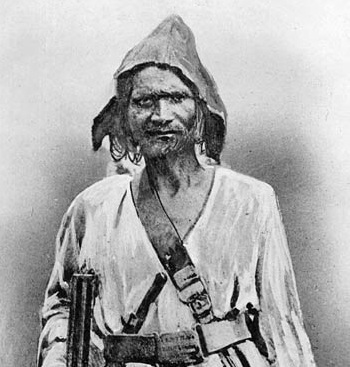 42. The name of his father was Bhau Singh. Tatya lost his mother in his early childhood. Bhau Singh devoted himself to the upbringing of Tatya. Keeping the traditions of the tribe, Tatya was thought archery and pole war. Tatya was the cynosure of the whole village. His humility and good nature endeared him to everyone.
42. The name of his father was Bhau Singh. Tatya lost his mother in his early childhood. Bhau Singh devoted himself to the upbringing of Tatya. Keeping the traditions of the tribe, Tatya was thought archery and pole war. Tatya was the cynosure of the whole village. His humility and good nature endeared him to everyone.
As he grew, Tatya Bheel turned into a powerful leader of hundreds of villages. He used to easily solve difficult cases of dispute. Even with thousands of of soldiers, it became difficult for the British to catch Tatya. He was as swift as wind.
Tatya was against any form of exploitation. He opposed feudal lords and extortionists. Later He led and armed rebellion against the British.
Tatya encouraged his people to own their own land and the produce of their blood and sweat. The extortionists sent him to jail. When Tatya came out after a year, he took the freedom struggle of 1857 to deep forest areas. He met Tatya Tope as well. He escaped jail once again. But the treachery of his own kinsman gave him to police one last time in 1886. On 4th December 1889, he was hanged.
Tatya Bheel is immortal. The tales of his bravery are sung in the region. A state university in Khandwa has been named after the immortal martyr Tatya Bheel.
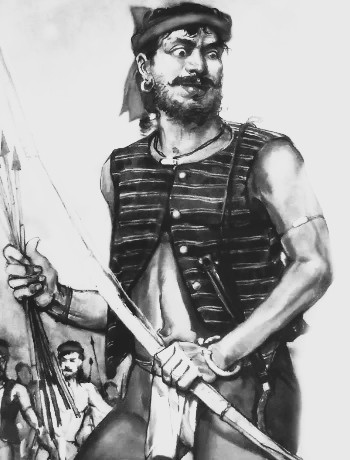 Bheema Nayak was born in 1815 in Panchmohli village, Barwani, Madhya Pradesh. At an early age of ten, Bheema became highly skilled in warfare. He knew archery and gofun. His parents instilled in him love for the country and the necessity of fighting injustice. His father Ramaa taught him warfare. His mother Sursi stood by His cause till she herself died in a British jail. In 1837, Bheema started building his army against the British. Within one year, he had five hundred trained soldiers. The tribes, Bheema, Bheel, Bhilala and Makrani supported him. Bheema build a fort for the security of his men in Dhanabawri.
Bheema Nayak was born in 1815 in Panchmohli village, Barwani, Madhya Pradesh. At an early age of ten, Bheema became highly skilled in warfare. He knew archery and gofun. His parents instilled in him love for the country and the necessity of fighting injustice. His father Ramaa taught him warfare. His mother Sursi stood by His cause till she herself died in a British jail. In 1837, Bheema started building his army against the British. Within one year, he had five hundred trained soldiers. The tribes, Bheema, Bheel, Bhilala and Makrani supported him. Bheema build a fort for the security of his men in Dhanabawri.
Even during famine, the British levied taxes. It was extortion from the poorest of the poor. Bheema looted government treasury and also the rich. He distributed the money among the poor. The British called army from Gujarat to capture Bheel warriors. Bheema and his fellow revolutionaries moved towards Sendhva region. Bheema led the revolution bravely. The hero of 1857 freedom struggle, came to Nimar in November 1858. Bheema helped him in crossing the river Narmada.
On 4th February 1859, and army unit under Keting attacked Dholabawri and on 13th February 1859, they attacked the village of Bheema, Panchmohli. About ten important fighters of Bheema's army were killed and many were captured. His mother Sursi was put in jail. She was tortured till she died on 28th February 1859. His associate Khojeb Singh was also tortured in inhuman ways. Bheema went into the thick forest. The day Sursi died, there was a rebellion in the jail of Mandaleshwar. The political agent of Nimar, Captain E. Thomson chaired judicial proceedings and gave capital punishment to Khajan Bundis, Jhagga, Narsing Nihal, Shekh Mohd., Haji Amin and Dilsher Khan. Mayaram, Jawahar Singh, Phutta, Bahadur Singh, Nuna Devi and Manju Shah were sent to isolated imprisonment in Andaman and Nicobar islands. All this cruelty could not douse off the fire of freedom in Bheel leaders. On 16th December 1866, they chased Britishers on streets and beat them. On 2nd April 1867 Bheema was captured on the information of a mole. But the name of Bheema Nayak kept the spark alive and the fight for freedom continued.
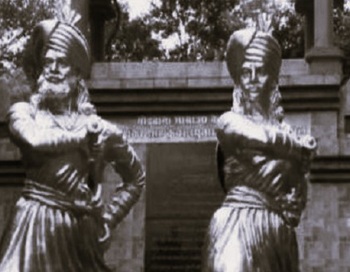 Raja Shankar Shah and his son Rahgunath Shah were brave and glorious kings of Gondwana. They belonged to the royal Gond clan. Raja Shankar Shah laid down his life for the freedom of the country in 1857 freedom struggle. His son Raghunath Shah was a capable son of a capable father. The clan had many kings who died for the cause of the country, religion and the culture of our dear motherland. The elder son of Raja Shankar Shah, Dalpat Shah, his wife Rani Durgawati and his son Veer Narayan died protecting their area from the Islamic onslaught after this incident Mandla and nearby area came under the control of Akbar. Akbar made the younger brother of Dalpat Shah whose name was Chandra Naresh Shah the king. In this clan only in the 11Th generation, immortal martyr Shankar Shah was born. He and his son fought in the 1857 freedom struggle till they died. In 1857 in order to free the country from the British, Raja Shankar Shah and his son Raghunath Shah, faught bravely and laid down their lives.
Raja Shankar Shah and his son Rahgunath Shah were brave and glorious kings of Gondwana. They belonged to the royal Gond clan. Raja Shankar Shah laid down his life for the freedom of the country in 1857 freedom struggle. His son Raghunath Shah was a capable son of a capable father. The clan had many kings who died for the cause of the country, religion and the culture of our dear motherland. The elder son of Raja Shankar Shah, Dalpat Shah, his wife Rani Durgawati and his son Veer Narayan died protecting their area from the Islamic onslaught after this incident Mandla and nearby area came under the control of Akbar. Akbar made the younger brother of Dalpat Shah whose name was Chandra Naresh Shah the king. In this clan only in the 11Th generation, immortal martyr Shankar Shah was born. He and his son fought in the 1857 freedom struggle till they died. In 1857 in order to free the country from the British, Raja Shankar Shah and his son Raghunath Shah, faught bravely and laid down their lives.
In Jabalpur in the 52nd regiment of the British Lieutenant, General Clark was very cruel and cunning. He tortured the public relentlessly. He sent his spies to the palace of Gadhpurwa. The spies came in the attire of saints and religious leaders. Raja Shankar Shah did not understand that those apparently holy men were spies of the British. In the night of 14th Sep. 1857 the spies and the army of the British imprisoned Raja Shanakar Shah and his son Raghunath Shah. They scanned the whole palace for proof. All that they could get was a poem. Raja Shankar Shah in a letter to his land lords had written a poem inspiring them to attack the British like the war goddess Maa Chandi.

This hand written poem was made into a proof against Raja Shankar Shah. On 18th Sep. 1857 both father and son were killed by the British in Jabalpur. The charge against them was writing a poem against the rulers and instigating rebellion. This is the first incident in world history where someone received capital punishment, a death sentence for writing a poem.
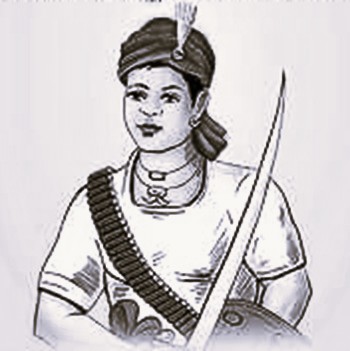 Veer Baburao Shedmake was born in the family of a landlord on 12th March 1883 in Chandrapur, Maharashtra. Right from his childhood he was interested in wrestling, sword wielding, bow and arrow, javelin throw and all other kinds of warfare. He was educated in Raipur. At Raipur he learned social and moral values. He was married to the landlord family of Adilabad, Andhra Pradesh. He saw how in the name of charity, Christian missionaries forced change of religion among tribes. He also saw exploitation of money lendars and the British. He saw how native culture was being systematically eroded. He felt a great desire of rebellion. He decided to fight against the injustice. On 24th Sep. 1857, he established Jungom Sena. He made an army from various tribes and trained them. He declared war against the British on 07th March 1858. Baburao and his companions completely captured Rajgarh.
Veer Baburao Shedmake was born in the family of a landlord on 12th March 1883 in Chandrapur, Maharashtra. Right from his childhood he was interested in wrestling, sword wielding, bow and arrow, javelin throw and all other kinds of warfare. He was educated in Raipur. At Raipur he learned social and moral values. He was married to the landlord family of Adilabad, Andhra Pradesh. He saw how in the name of charity, Christian missionaries forced change of religion among tribes. He also saw exploitation of money lendars and the British. He saw how native culture was being systematically eroded. He felt a great desire of rebellion. He decided to fight against the injustice. On 24th Sep. 1857, he established Jungom Sena. He made an army from various tribes and trained them. He declared war against the British on 07th March 1858. Baburao and his companions completely captured Rajgarh.
On 28th March 1858 early in the morning at 04:00 am the British army encircled the hillock where Baburao was staying. Replying to them, the soldiers of Baburao threw stones and caused big damage to the British army. Jungom Sena won. Baburao opened his stock of grains for the general public. On 19th April 1858 once again the army of Baburao defeated the British in Sagnapur. On 29th April 1858 these revolutionaries attacked a Brtisih cantonment at Chichguki and they killed telegram operators Guarded and Hole. Queen Victoria was informed about this incident. She ordered to capture Baburao dead or alive. With cunning deceit and with internal sabotage Baburao Shedmake was captured. Without any proper justice system he was hanged to death on 21st Oct. 1858. Again and again we see how cheat, deceit, stealth and deception were used by the British to defeat the glorious and brave fighters of India.
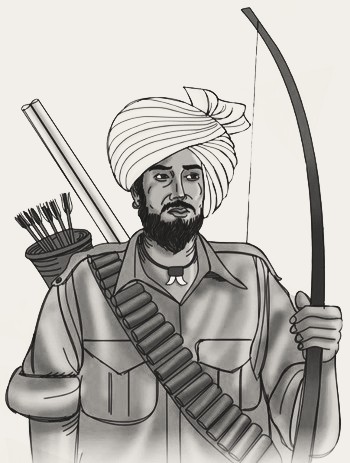 In Badwani, Nimad, Madhya Pradesh Khajya Naik was born. This unsung hero of 1857 freedom struggle fought for protecting the country, religion and culture. After the death of his father in 1833 Khajya Naik was made the Chief of Sendhva. He was imprisoned by the British in 1850 and he was freed in 1856. He was offered a job by the Government but self respecting Khajya rejected that offer. In 1857 with the help of 700 Bheel tribes soldiers, he established his control over the valley of Sendhva. He looted a sum of Rs. 17 Lakh from the British and distributed it among the poorest of the poor in Sendhva valley. He fought bravely against the British. British Major Evans came to know that Khajya and his men live in Ambapani jungle near Badwani. They attacked Khajya and his army. Many important officers including his son Fauladi Singh was killed. But Khajya was not disappointed and he kept fighting the british with his full might. The Collector of Dhulia asked Khajya to surrender alone conditionally but Khajya rejected the offer completely. He shocked the British on 26th Oct. and 17th Nov. 1857 when he successfully looted the treasury of British. The fight in Ambapani and Jambhili chowk are very famous even to this day. He used to distribute all his loot among the poor. Even when the struggle of 1857 came to an end, Khajya kept on fighting with all that he had On 03rd Oct. 1860 his own army man, a Muslim named Rohitudeen cheated him and shot bullets into the body of Khajya Naik when he was worshipping the sun after morting bath. Rohitudeen was given a job by the British as a prize.
In Badwani, Nimad, Madhya Pradesh Khajya Naik was born. This unsung hero of 1857 freedom struggle fought for protecting the country, religion and culture. After the death of his father in 1833 Khajya Naik was made the Chief of Sendhva. He was imprisoned by the British in 1850 and he was freed in 1856. He was offered a job by the Government but self respecting Khajya rejected that offer. In 1857 with the help of 700 Bheel tribes soldiers, he established his control over the valley of Sendhva. He looted a sum of Rs. 17 Lakh from the British and distributed it among the poorest of the poor in Sendhva valley. He fought bravely against the British. British Major Evans came to know that Khajya and his men live in Ambapani jungle near Badwani. They attacked Khajya and his army. Many important officers including his son Fauladi Singh was killed. But Khajya was not disappointed and he kept fighting the british with his full might. The Collector of Dhulia asked Khajya to surrender alone conditionally but Khajya rejected the offer completely. He shocked the British on 26th Oct. and 17th Nov. 1857 when he successfully looted the treasury of British. The fight in Ambapani and Jambhili chowk are very famous even to this day. He used to distribute all his loot among the poor. Even when the struggle of 1857 came to an end, Khajya kept on fighting with all that he had On 03rd Oct. 1860 his own army man, a Muslim named Rohitudeen cheated him and shot bullets into the body of Khajya Naik when he was worshipping the sun after morting bath. Rohitudeen was given a job by the British as a prize.
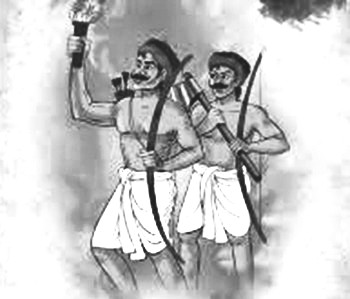 In Bihar 65 km. away from Gandhva district there is a village Chemo-Sanya. In the beautiful landscape of Vananchal in the Kharbar tribe two boys Neelambar and Peetambar were born to Shreemati Saniya Devi and Shri Chemo Singh. In childhood they used to ask their parents about the presence of white men in their village. Their parents told them that they were foreigners and they were ruling our country. Both the brothers decided that they would learn the art of warfare and alongwith their companions they would free the country from the grip of the British. They were experts in sword wielding. In May 1857. Peetambar came to Ranchi for some specific work. He came to know that some soldeirs had rebelled against the British. When he returned home, he told his elder brother Neelambar about the struggle of the soldiers.
In Bihar 65 km. away from Gandhva district there is a village Chemo-Sanya. In the beautiful landscape of Vananchal in the Kharbar tribe two boys Neelambar and Peetambar were born to Shreemati Saniya Devi and Shri Chemo Singh. In childhood they used to ask their parents about the presence of white men in their village. Their parents told them that they were foreigners and they were ruling our country. Both the brothers decided that they would learn the art of warfare and alongwith their companions they would free the country from the grip of the British. They were experts in sword wielding. In May 1857. Peetambar came to Ranchi for some specific work. He came to know that some soldeirs had rebelled against the British. When he returned home, he told his elder brother Neelambar about the struggle of the soldiers.
On 21st Oct 1857 Neelambar and Peetambar started their war. They also got the support of the king of Cheron who gave them his soldiers. Neelambar and Peetambar were leaders of this war. The British were afraid of them. On 27th Nov. 1857 they captured Raj Hara Station but cunningly the British shifted their base to Mandi and Milija.
On 21st Jan. 1857 in Palmu Fort the British and Neelambar and Peetambar started fighting. On one side was the army of Neelambar and Peetmbar and on the other side of army of the murderer Colonel Dalton and Lieutenant Graham were fighting. Unfortunately during the war one commander of the army of Neelambar-Peetambar named Jagatpal Singh Kharbar went to the side of the British. The British came to know about the fighting strategy of Neelambar-Peetambar. They imprisoned Lieutenant Tikait of Manica and Bhikhari Singh Kharbar who died in the captivity of the British and yet they did not disclose the strategy of Neelam-Peetambar to the British. Lieutenant Graham worked all the time to weaken the struggle of Neelambar-Peetambar. He declared prizes of cash and land to those who would give information about Neelambar-Peetambar. The British tortured the innocent villagers when Neelambar-Peetambar went to meet the villagers. The insidious insiders informed the British Colonel Dalton about the brave brothers. They captured two brothers after a fierce battle on 28th March 1858. The two brave brothers Neelambar and Peetambar touched the soil of the motherland one last time. They went to gallows smilingly. They were martyred publically.
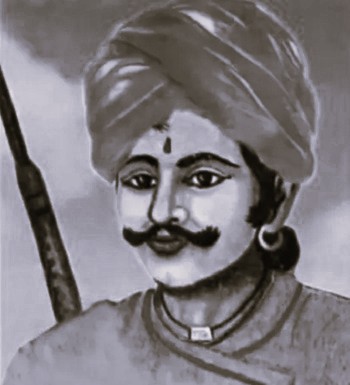 Bhagoji Naik belonged to Naandoor Singote village, Sinner district Nasik, Maharashtra. In 1855 he was imprisoned for instigating rebellion amongst Bheels. After one year he was released. He started organizing his army and even today the valley on Nasik Pune road, where Bhagoji Naik attacked the British is named after him. The news of Bhagoji Naik killing Hendry enthused Bheel Mahadev Koli community. He and his men fought the British bravely. He attacked forts and treasuries and used the money for raising rebellion. He fought a number of battles against the British and he died in one such battle in 1859.
Bhagoji Naik belonged to Naandoor Singote village, Sinner district Nasik, Maharashtra. In 1855 he was imprisoned for instigating rebellion amongst Bheels. After one year he was released. He started organizing his army and even today the valley on Nasik Pune road, where Bhagoji Naik attacked the British is named after him. The news of Bhagoji Naik killing Hendry enthused Bheel Mahadev Koli community. He and his men fought the British bravely. He attacked forts and treasuries and used the money for raising rebellion. He fought a number of battles against the British and he died in one such battle in 1859.
Raghunath Singh Mandloi was a leader from Bhilala tribe. He belonged to Badwani, Madhya Pradesh. His clan was responsible for security and administration of some villages. They worked under the Holkar dynasty. Bhilala tribe was a tribe of fighters. The father of Raghunath Singh was a just and efficient administrator. Raghunath Singh also inherited these qualities. He had an attractive personality and he was very brave. In 1857 he participated in freedom struggle in Malva Nimar region.
On 30th Sep. 1858 Raghunath Singh and his companions captured the police station in Balmukund. They also burnt the police station at Jamuni on 18th Oct 1858. Raghunath Singh along with Sita Ram Kanwar fought the British in a place called a Buned. The revolutionaries defeated the British and they went towards the jungle where Sitaram Kanwar was martyred. Raghunath Singh increased his activities. Many times the British tried to capture him but they failed. On 08th Oct. 1858 the British requested for talks but they deceived him and imprisoned him. Keeping his high stature he was kept not in a regular jail but at a better place. This tribal hero gave his life for the freedom of the country.
Delan Shah of Dheelawar Narsinghpur, Madhya Pradesh belonged to the Gond tribe. He was born in 1802 in Bundelkhand region of Madhya Pradesh. Gond kings ruled in the regionfor a long time. About 60 Km. away from Narsinghpur there is a place called Tendukheda. Earlier it was known as Ramgarh. Here the brave warrior Delan Shah was born. He was fearless, brave and determined right from his childhood. When he was just 17 or 18 year of age he caught the head of a snake and threw it away. At the age of 19 he freed a person from dacoits. Right from childhood he showed qualities of leadership. At the age of 22, he was married in the kingdom of Chhindwara. The name of his wife was Madan Bai.
In the beginning of 19th century the British started expanding themselves into various parts of central India. In 1817 they came to Narsinghpur. In 1818, they started their administration through a council. Bhonsle of Nagpur. Scindia of Gwalior and Bundelas of Panna ruled various regions.
In 1818 Delan Shah publically took off the Union Jack, the flag of the British. He kept on working and spreading awareness against the British. In 1836 he again tried to chase away the British. During this period, there was dissatisfaction and rebellion against the British in various parts of the country. After the death of Raghunath Shah, Delan Shah attacked the British in Tendukheda and Chanwar Patha and he succeeded. In 1858 the British army came back to the area. Because of shortage of arms he was made a captive. He was hanged publically on a peepal three in Dheelagarh.
Immortal martyr Veer Narayan Singh of Sonakhan, Raipur, Chhatisgarh belonged to Bhinjwar tribe. He valiantly participated in the freedom struggle of 1857. His father was a landlord. Veer Narayan Singh born in 1795. After the death of his father 1830 Narayan Singh became the landlord. He immensely cared for his people. He went to villages, listened to the problems of the people, solved their problems and spoke humbly to them. He constructed many ponds for water conservation and he carried out tree plantation on a big scale. Narayan Singh was deeply religious. His temperament was very good. In 1856 in Chhatisgarh, there was a famine. People had nothing to eat but Narayan Singh broke the locks of store houses and go-downs of stock holders who were not giving necessary grains to people. For helping the people of his area he was imprisoned on 24th Oct. 1956. The stock holders of grains were behind his imprisonment.
The cruel British authorities snapped the cases of decoity on Veer Narayan Singh. The one who helped the poor was kept in jail and exploitative stockists were given protection. On 28th Aug 1957. Veer Narayan Singh escaped the jail with his three friends. Looking at Veer Narayan Singh, the people of Sonakhan danced. They felt immense self-confidence. The people of the area gathered under the leadership of Narayan Singh and they made an army. When Deputy Commissioner Smith came to know about it, he planned to crush the rebellion. On 29th Nov, his army went to Sonakhan and saw that the whole village was vacant. There was no one in the village. In rage he burnt the whole village. Sonakhan became ashes. When Smith was returning, the army of Narayan Singh fired on him from the hills. Smith escaped from there. He called a huge number of army men on 12nd Dec. He encircled the whole mountain. After a fierce battle Veer Narayan Singh was captured and sent to Raipur jail. On 10th Dec 1857. Veer Narayan Singh was hanged publically at the main chowk of Raipur. Even to this day the chowk is known by the name of this immortal martyer of India.
Veer Ramji Gond belonged to Sonkhas, Adilabaad, Telangana. He belonged to Gond tribe. He was a prominent figure of 1857 freedom struggle. Under the guidance of Tatya Tope he built an army of rebels and controlled the area in and around Nirmal city. Even though the Nizam was with the British, Ramji Gond succeeded in holding the British for quite some time. The special thing about Ramji Gond was that he was part of the mainstream of 1857 freedom struggle alongwith the Peshvas, Tatya Tope and Mangal Pandey. For a brief period of about three years, he held his region safe. He was very popular. He was a magnetic leader. He had tremendous organizing skills. But like all our unsung heroes of the India freedom struggle, Ramji Gond was also hanged publically on a Baniyan tree. Adilabad and nearby areas know this hero very well and even that tree is marked where he was myrtered.
Freedom fighter Telangana Khadiya belonged to Gumla in Jharkhand. He was born in 1806 and he was myrtered in 1880. He belonged to Khadiya tribe. He understood the cunningness of the British very well. He was imprisoned for some time and then released but he never left his mission of freeing the country from the British. Khadiya he died in a fierce a gun battle with the British.
It is clear that rage against the British had spread all across the country. The tribes played a very crucial role in the freedom struggle. The tribes of India are inherently brave and they acted likewise. It is also clear that all the heroic activities of the tribes came to a null in front of cunningness of the British, their malicious planning and their advanced gun power. Our tribes were fighting with stones, javelins, arrows and spears. The British were fighting with guns and canons. It is also clear that the British religiously followed the policy of “Divide and Rule”. They understood and depended the faults lines within the Indian Society in the form of caste and religion. They defeated Indians with the help of Indians. The stories of these brave freedom fighters should be studied in order to underline the resilient Indian spirit and also to take lessons from our mistakes of the past. India was subjugated because India was divided. Now, we must never repeat the mistake.
To be continued…
Note: - Translated from “Janjati Gauravgatha” published by Vangunjan Prakashan.
31-May-2025
More by : Prof. Shubha Tiwari

|
Thought provoking. Definitely lesson should be taken from history |

|
Though provoking article madam Definitely lesson should be taken from history |

|
The text is well organised exploration from SL into TL . This enlightened work will enhance the understanding of the readers about the tribal freedom fighters. The article is true homage to the tribal lions who roared against the British rule . The fluency and syntactic structures add beauty to the entire text. |